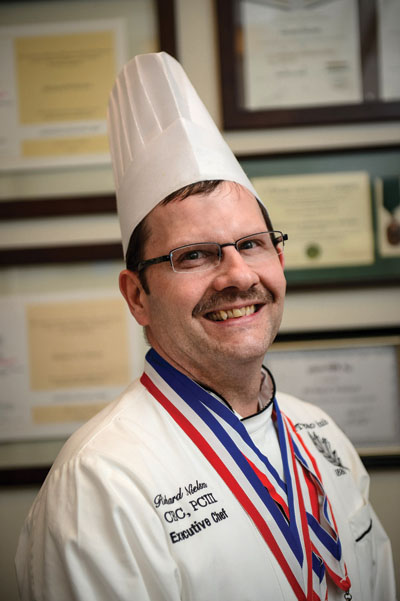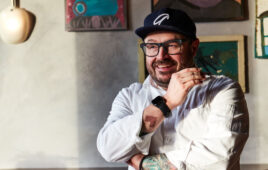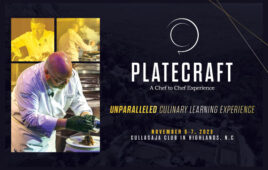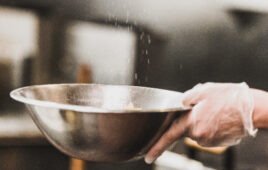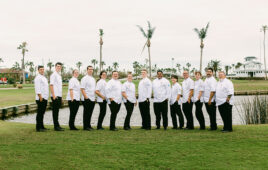Over 125 years ago, a member of The Tuxedo Club helped spread the fame of the formalwear now known by that name. Today, Executive Chef Richard Nielsen, CEC, PCIII, is making the club’s menus look and taste their finest, too.
There are differing reports about where the dinner jacket known around the world as the tuxedo originated. One account, though, seems to be the most authentic.
In 1886, James Brown Potter, a member of The Tuxedo Club in Tuxedo Park, N.Y., a village some 50 miles north of New York City, brought back a jacket from England that had been recommended to him by the Prince of Wales. It was shorter than the tailcoats worn during that time, and was thought to be more appropriate for less-formal dinners. Its popularity spread through New York’s fashion circles, and the name tuxedo became forever associated with this style of formal wear.
| Richard Nielsen, CEC, PCIII CHEF PROFILE Current Position:
Previous Experience:
Education:
Memberships/Certifications:
|
Fittingly, The Tuxedo Club has also become known as an elegant playground for the elite of New York and its environs. Since 2011, Chef Richard Nielsen, CEC, PCIII, has been the man in charge of the great food served at the club. After graduating from the Culinary Institute of America in Hyde Park, N.Y., in 1990, Chef Nielsen is back in New York state preparing his “new American” cuisine and utilizing local purveyors and nearby farmers’ products. We appreciate Chef Nielsen taking time during his peak-season crunch to share some thoughts on what it takes to be a top club chef.
Q: Chef, early in your career you externed at Chef Paul Prudhomme’s K-Paul’s restaurant in New York City. What are some of the things you learned from that experience and still look back on today?
A :One of my most cherished experiences was having Paul Prudhomme teach me how to taste and develop layers of flavor while preparing a classic Chicken and Andouille Gumbo. The time, effort and love that he put into making his gumbo inspired me as a young and impressionable cook. There was attention to every detail: roasting the bones to make the stock, making the sausage, smoking the chickens, getting the color of the roux just right, the proper amount of trinity (onions, celery and bell peppers), adding the trinity to the roux to cool it down so it would both cook the vegetables and stop the roux from becoming overcooked and bitter, and of course how to properly season to stimulate the palate.
Chef Paul and his culinary team inspired me every day and encouraged me to cook with passion, and the flavors will come. At the end of my externship, Chef Paul gave me a signed copy of his book, Chef Paul Prudhomme’s Louisiana Kitchen, with the following note: “Good Cooking, Good Eating, Good Loving.”
Q: Your own externship program at The Tuxedo Club is very well-organized and spelled out on your club’s website. Can you share where people can access the schedule you’ve set up for the externs, how you’ve detailed what they can expect, and how this has helped the program’s overall success?
A: At The Tuxedo Club, we have an exciting Culinary Externship, as well as Golf Course Management and Hospitality Club Management programs, to encourage and develop current students for tomorrow’s leadership roles. To access these programs as a reference in developing your own programs, visit our website, www.thetuxedoclub.org, and click on the “About Our Club” header, then scroll down to “Internships.”
Our Culinary Externship program was established in 2012, following approval by the Culinary Institute of America. Last season we recruited two externs from the CIA, one from the Club Managers Association of America, and a couple of recent culinary graduates for seasonal positions. This season we have four externs, three from the CIA and one from Le Cordon Bleu.
My emphasis is helping the externs transition from classroom to kitchen while building and strengthening the skills they have acquired to date. As long as the externs come in with the desire to learn and work, they will be successful and learn a lot.
Q: Chef, you do quite a bit of off-site catering in Tuxedo Park. What tips can you offer those who are thinking of granting their members’ requests to have parties in their homes?
A: We have multiple venues at The Tuxedo Club that we cater to on a regular basis. Executing parties in our members’ homes is just an extension of that catering for us. Some helpful tips for executing successful in-home catering events are:
• Be realistic with what you can do.
• Make a detailed packing list of all equipment and food needed.
• Perform a site inspection of the home and make a detailed diagram of the kitchen, preparation, storage, and serving spaces.
• Prepare enough mise en place to cover those unexpected guests and special requests.
• Have enough staff to cover culinary needs as well as service needs—and then add a couple more.
• Prepare a timeline of prep and service times, and add extra time (arrive early, and prepare to stay later).
• Prepare a detailed diagram of plating procedures for each course.
• Bring a camera and take pictures.
I also can’t emphasize enough the importance of utilizing professional staff with personality. Our members very much enjoy interacting with culinary staff and watching them as they prepare components of their meal beforehand. It is a necessity that the culinary staff is personable, organized, and detailed.
Q: Education on a continuing basis has clearly been important to you during your own career. Since you received your CEC over 16 years ago, you’ve done a few recertifications that are required every five years. Can you explain what some of the most recent ones have been like?
A: Having earned the professional designation of Certified Executive Chef since May 1998, I’ve had to recertify three times, in 2003, 2008 and 2013. Overall, the recertification process is quite painless, as long as the required documentation is readily available. The 80 needed education hours are available through a myriad of professional development activities, including conferences, continuing education courses, ACF-sanctioned culinary competitions, online courses, meetings, seminars, etc.
Successfully completing the ProChef Level III Certification Exam in March 2008 enabled me to obtain dual certification through both the CIA and the ACF. This was by far the most challenging recertification to date, but also the most fulfilling. My most recent recertification, in May 2013, was acquired with hours from ACF competitions; online refresher courses for safety and sanitation, culinary nutrition and supervisory management; a food safety manager certification exam; and a sous vide cooking continuing education course at the CIA.
Q: Can you share the discussion you had with your daughter Gabrielle when she decided to attend the Culinary Institute of America—despite your warnings that did not make her change her mind?
A: I think my wife and I knew she would end up at the CIA before she did. Her high-school years were a period of self-discovery and as she approached each year, her desire to follow in my footsteps became more obvious. I suggested she come to work with me the summer before her junior year, so she could get a feel for the kitchen environment and the demands of choosing this career. She spent a lot of time working on knife cuts, something I know she now appreciates a great deal.
As Gabrielle stepped out of the classroom and into the kitchen, I saw her come alive. She listened, was focused, and wanted to learn as much as I could teach her. After the initial “No, don’t do it!” comments, my wife and I both had discussions with Gabrielle regarding her intended career choice. I believe her friends didn’t even know she had a father until high school, as my wife was the only parent they all saw regularly at school and around town. She grew up with a father who worked most every weekend, birthdays, holidays, family gatherings, etc. She was well aware of the hours I spent at work away from home and family, the early mornings and late nights. Our holidays were spent, in reality, post-holiday.
When asked “Are you sure this is what you want?” her reply was always, “I just want to cook good food and can’t see myself doing anything else.” Her determination and dedication to the culinary industry was unrelenting. Her graduation day was a very proud moment for us, and I was thrilled to place her culinary cordon around her neck at graduation. My son, Anthony, is also in hospitality, pursuing a career in the front of the house—which all makes for a mighty lonely dinner table for my wife come the holidays!
Q: Chef, I sent a sous chef to ProChef II certification at CIA San Antonio, and he came back really excited about the program. I don’t think many chefs have a full appreciation for just how comprehensive and intensive this program is. Can you give us some details on your experience at Hyde Park attending both ProChef II and III, and the value you gained from it?
A: The ProChef Level III Immersion and Certification Exam taught me the importance of continuing education and how this affects my individual performance and also the culinary team’s dynamics. To be tested on not just written but practical competencies is a true measure of a chef’s ability to perform his craft to the highest standard under immense pressure and fatigue. I gained so much knowledge and respect for my craft from this achievement.
When I arrived on the Hyde Park campus for day one of the ProChef Level II exam, I knew that my culinary management, financial analytical, and baking/pastry skills would be thoroughly tested. I had downloaded and reviewed the study guide readily available on the ProChef website to identify my strengths and weaknesses at first glance. I reviewed the list of recommended textbooks and workbooks and began studying, and felt confident in my abilities and knowledge for most areas of the exam.
I did decide to take the Mediterranean Cuisine and Techniques of Healthy Cooking courses prior to taking the ProChef Level II Exam. I had already identified healthy cooking as my personal challenge—executing big flavors with limited calories and within the nutritional guidelines provided and verified through a nutritional analysis. As it turned out, I did not pass the Level II exam the first time I took it due mostly to a careless oversight on my part, falling just short of utilizing all of the allotted calories in my dish.
Although disappointed, I did not let that failure define me, and followed up with a second test when my schedule allowed the following year. I can’t say that I prepared more between exams this time; I was simply more equipped mentally to handle the long days and short nights during the test. I was determined to face the challenge of healthy cooking head-on, and made sure to not fall short.
Upon returning home, I knew I was going to take the ProChef Level III Immersion and Certification Exam the following spring of 2008. The three weeks spent at the CIA for the purposes of completing the Level III Immersion and Certification Exam were exceptionally intense and the expectations were extremely high. During the first two weeks, my schedule included a morning class from 7:00 a.m.–1:30 p.m. and an afternoon class from 2:00 p.m–8:30 p.m.
After speaking with the exam proctor, Chef Crispo, three days into the first week, it was clear that any preparation I could do prior to receiving my individual assignments for the practical exam would be critical, and therefore I had to prepare for any scenario. Due to the limited amount of time during the week to complete research for the exam competencies, most of the first weekend was spent at the library gathering information on the five countries that made up the Asian cuisine competency and compiling various scenarios/menus for which I could be tested. The following weekend, I gathered information for the Latin America/Caribbean cuisine competency and compiled various scenarios/menus for which I could be tested.
We were told that all correspondence regarding the exam would come via e-mail. I received my assignments for the practical examination at 2:04 a.m. on Wednesday of my second week of classes. Unfortunately, I had shut down my computer at 1:30 a.m., finally finished with my studies for the day.
When I arrived at the campus on Wednesday morning, Chef Crispo asked me if I had received my competency information via e-mail. My initial response was “No, as of 1:30 a.m.,” and he suggested that I check my e-mail again. He told me that I needed to have my food orders in to him via e-mail by 5:00 p.m. on Thursday. I asked him if he was aware that we would be in class until 8:30 p.m. tonight and would return to class by 7:00 a.m. on the due date and he replied “Yes” and walked off down the hall. Knowing the value of my time and that we would be in class until at least 8:30 p.m., I used the program administrator’s computer to print out my assignment, knowing I would not be able to do anything more until after class. The fun was about to begin!
That evening after class, I immediately went to my room and began to compile my recipes that I would be preparing for the Asian cuisine competency (India) and the Latin America/Caribbean Cuisine Competency (Mexico). I was up until 4:30 am completing my menus and recipes and then e-mailed my food order to the chef, so I would have the ingredients necessary to complete my competency on the first two test days.
At 6:30 a.m. I arrived on campus to print out all the information I submitted to Chef Crispo the night before to document my submittal. Upon the advice of one of the chef instructors, I made plans to visit a Mexican market and restaurant and an Indian market and restaurant to purchase authentic ingredients to use during my exam. Eating in each restaurant enabled me to taste authentic cuisine, ask questions of staff, and observe how food from each country is prepared and served. After my field trips, I tweaked the recipes I had previously submitted, compiled my supplemental food orders and prepared history pages, production timelines, equipment lists and written menus for the chefs.
On the first day of testing, we received our financial market basket and completed the written test on Latin American/Caribbean cuisine. The next phase of the test was to prepare an authentic, three-course Mexican menu, using my assigned protein of turkey and incorporating my assigned competency of mole into my menu.
We had three hours to prepare the menu and fifteen minutes to plate up four portions for critique. During the examination, two kitchen judges monitored fabrication and product utilization, station setup and sanitation, cooking techniques, timing of plating service, and everything else!
After completing plating, I cleaned my station and waited for the judges to finish critiquing my food. I was then called in to discuss how my menu fit into the assigned country and my assigned competencies. I was then asked to critique my food and cooking techniques, justify why I chose these recipes, and how I thought they represented the cooking methods, flavor profiles, and culture of the indigenous people.
After this interrogation, two tasting judges (chefs) critiqued my dishes based on their expertise and written evaluation standards. Afterwards, the two kitchen judges (chefs) gave their critiques. I then left the room for 30 minutes and was called back in to receive my scores for the day. Upon dismissal, I went back to my hotel room to repeat the same preparation steps for my Asian cuisine practical exam, take notes on the financial market basket, and study for the Asian cuisine written test. My first day of testing and prep for testing on day two ended at 2:30 a.m.
On the second day of testing, I began with the Asian cuisine written test at 7:00 a.m. I also received the market basket of food and two wines for the practical cooking examination on the third day. I tasted the wines and had two hours to write my four-course menu. I had three hours to complete the Asian cuisine (India) competency, and fifteen minutes to plate four portions. Critiques followed in the same manner as day one.
On the third day, I was given four hours to complete production of a four-course menu, and the wines were required to be paired with two courses. I received two French wines, a red and a white wine. I decided to create a French menu that complemented the wines. Critiques followed in the same manner as day one.
After critiques, we watched five management vignettes and were required to analyze the issues presented. After watching the management vignettes, I went back to my room to create my PowerPoint presentation of the financial market basket and prepare my presentation of the management vignette to two industry experts. Day three for me ended at 4:30 a.m.
The fourth and final day of testing included presentations to two industry experts on the management vignettes and financial market basket. Requirements for the management vignette included discussion of employment laws, sound management techniques, enforcement of company guidelines and procedures, as well as identification of any financial ramifications that could arise from poor management techniques. I also had to role-play certain situations while the proctors tested our management and decision making abilities.
The proctors wanted to know our decisions regarding the vignettes, the thought process involved in making specific decisions, and the manner in which such decisions could impact the company in both positive and negative ways. The financial market basket was presented in PowerPoint and detailed all the issues I extracted from the information provided earlier in the week. I was required to identify all of the problem areas, show how they affected the net worth of the company, provide solutions to these problems, and recommend future improvements. My presentation included financial data supporting these changes and justified these changes and recommendations based on sound accounting practices.
Only two candidates participated in the exam, and both passed. I was the only candidate from the immersion courses to take the exam. We stated the culinarian’s code on the new Professional Chef book and rededicated ourselves back to the industry that we were apart from for three weeks.


